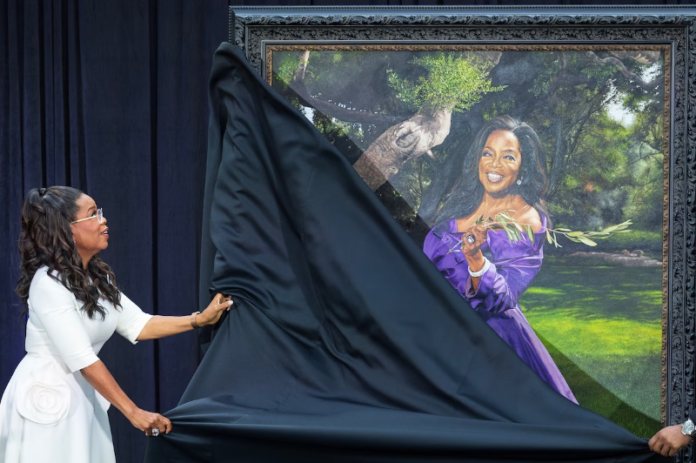Портрет медіа-магната роботи художника Шона Майкла Уоррена представлений у Національній портретній галереї Смітсонівського музею, а оливкова гілка натякає багато на що.
Не існує єдиного стандарту, за яким чиєсь зображення вважається гідним того, щоб потрапити до Національної портретної галереї Смітсонівського музею. Політики, включаючи президентів, представлені просто тому, що вони мали владу, незалежно від того, як вони її використовували чи зловживали нею. Останнім часом панівною валютою є знаменитість, і в музеї досить агностично ставляться до того, які саме види слави вшановуються. Велике багатство також прославляється, хоча зазвичай у більш прийнятних термінах, таких як вплив, державна служба або філантропія.
Опра Вінфрі могла б увійти в будь-які з цих дверей: багатство, влада, вплив, навіть політичний вплив, зважаючи на те, що вона підтримала Барака Обаму на президентських виборах у 2006 році та запропонувала Мітту Ромні балотуватися проти Дональда Трампа у 2020 році. І ось тепер офіційна, замовлена картина з її зображенням увійшла до колекції Національної портретної галереї, приєднавшись до фотографій і гравюр, які документують десятиліття кар’єри ведучої денного ток-шоу і медіа-магната.
Одна справа – мати свій портрет у Національній портретній галереї. Зовсім інша – коли твій портрет офіційно відкривають там, у великому центральному атріумі перед натовпом захоплених глядачів. У середу вранці, коли портрет Вінфрі нарешті з’явився на світ, цей простір був переповнений і сповнений захоплення, як і відкриття портретів Барака і Мішель Обами в лютому 2018 року.
Вінфрі була присутня, як і чиказький художник Шон Майкл Уоррен, який намалював зображення в повний зріст. Лонні Г. Банч III, секретар Смітсонівського інституту і колишній директор-засновник Національного музею афроамериканської історії та культури, також був там, і він визнав, що підтримка Вінфрі цього молодого музею допомогла йому зайняти свою нинішню посаду.
“Ми, країна, в боргу перед тобою, Опра”, – сказав він перед відкриттям.
За 10 хвилин до того, як Вінфрі та представники Смітсонівського інституту вийшли на сцену, в залі запанувала благоговійна тиша.
“Як у церкві”, – сказала одна жінка в натовпі.
Так воно і було. О 10:12 ранку всі мобільні телефони в печерній кімнаті були спрямовані на подіум, де картина Уоррена була захована за чорною тканиною. Художник і Вінфрі зробили честь, обережно потягнувши за фату, яка впала, відкривши її в об’ємних складках фіолетової тафтової сукні, що стояла у власному молитовному саду, оточеному дубами, тримаючи у витягнутій лівій руці оливкову гілку.
Це традиційний образ, образна репрезентація, призначена для прочитання деталей і символізму, а не формальних експериментів. Вінфрі усміхнена і приваблива, лише кілька пасм сивого волосся нагадують про плин часу. Уоррен ефективно відтворив атласну текстуру сукні, а тіні за її спиною дають переконливе відчуття як теплого сонячного дня, так і прохолоди добре затіненого саду. Сад акуратно доглянутий, але не бездоганний, як і публічний образ Вінфрі: завжди майже ідеальний, але не зовсім, тому що її привабливість залежить від того, що вона людина, як і ми.
Уоррен обрав обережний, але розумний шлях, не надто переосмислюючи образ. Вінфрі – одна з найбільш фотографованих і знятих фігур у світі, яка насичена образами. Вона також, як відомо, заявила про незалежність від власного тіла: “Я точно знаю, що я – це не моє тіло”, – сказала вона після багатьох років мук через проблеми з фігурою та вагою.
Одного разу вона з’явилася на обкладинці журналу Forbes у королівській позі, нависаючи над Уорреном Баффетом і Біллом Гейтсом, які ввічливо сиділи під нею. Але Уоррен, який також намалював її в рамках спільного муралу в Чикаго у 2020 році, не пішов цим шляхом. Він також не зобразив, можливо, найбільш знакову з її поз – простягнуті руки, що ніби обіймають її глядачів, які захоплено відповідають жестом любові та ствердження.
Натомість художник обрав простоту, зафіксувавши зірку на самоті, щасливу, в мирі з собою, ніби вона з’явилася на обкладинці власного журналу.
Після показу Вінфрі розповіла, як вона це часто робить, про свій шлях від лахміття до багатства, про свої амбіції та вдячність, про те, як вона піднялася з бідності в сільській місцевості Міссісіпі до звання найбагатшої афроамериканки 20-го сторіччя. Вона згадала про знамениту ванну для прання, в якій її бабуся кип’ятила сімейний одяг, і про свою впевненість в дуже юному віці, що вона призначена для чогось кращого.
“Я живу і дихаю Божою мрією про мене сьогодні”, – сказала Вінфрі. Вона багато говорила про фіолетову сукню, улюблений колір, і про важливість своєї ролі у фільмі Стівена Спілберга “Пурпурний колір” 1985 року не тільки для її злету до слави, але й для її незалежності як артистки і підприємця.
Але вона не говорила про оливкову гілку, яка є єдиним, найбільш помітним символом на картині. Очевидно, що це загальновизнаний символ миру. Але це також глибоко християнський образ, перший маленький зелений знак надії, який голуб приніс Ною в його ковчег після того, як Бог знищив решту людства під час руйнівного потопу.
Символ миру і нагадування про жорстоку, примхливу природу нашого світу з привидами. Хотілося б почути більше про це від Вінфрі або Уоррена, але найближче, що вона зробила, це послалася на вірш Майї Анжелоу, написаний до 50-річчя Вінфрі. “Моє бажання для тебе – щоб ти продовжувала … дивувати жорстокий світ / Своїми добрими вчинками”, – сказала Вінфрі, читаючи по пам’яті оду, складену на її честь.
“Сьогодні я живу і дихаю Божою мрією про мене”, – сказала Вінфрі під час церемонії. Церемонія в середу була більш урочистою, ніж та, що відбулася п’ять років тому, після обрання Дональда Трампа, який перекреслив багато з того, що залишив Обама. Але оливкова гілка нагадує про прощальний характер більшості офіційних портретів. У Вінфрі-магната, без сумніву, попереду ще багато виступів, і вона зуміла вставити у свою промову згадку про майбутній римейк “Пурпурного кольору”. “Купуйте квитки вже зараз”, – сказала вона.
Але епоха Опри закінчилася. Десятиліттями вона пропонувала американцям спокусливу фантазію: що наші найбільші проблеми можна вирішити, обговоривши їх, зізнавшись у гріхах, обійнявши тих, кого ми вважаємо страшними або чужими. Це був останній розквіт ліберального ідеалу, кінець ери громадянських прав, минущий апогей американської надії між закінченням холодної війни і початком правління Обами.
Вінфрі запозичувала у політиків, а вони запозичували у відповідь, і на деякий час здавалося, що справді може існувати пост-расова Америка, що б це не означало. Вона виступала за правду і примирення, і Нельсон Мандела був гостем її програми. І Білл Клінтон, і Обама запозичили її підхід, використовуючи публічну сповідь як політичний інструмент для примирення. Аудиторія білих жінок не сприймала Вінфрі як чорношкіру, тоді як аудиторія чорношкірих жінок вважала її надихаючим прикладом афроамериканського успіху. Подібно до сонячного дня і насичених тіней на портреті, важко досягти такого ретельного балансу ідентичності, і неясно, чи вдасться це зробити комусь після неї в нашому поляризованому і жорстокому світі.
Дивно думати, що Америка породила і Опру, і Трампа, який прийшов як своєрідний анти-Опра, експлуатуючи безліч речей, які були стандартними темами її шоу: расизм, мізогінія, ксенофобія. Його стиль теж був анти-Опра: монолог, а не розмова, знущання і насмішки, а не співчуття, поділ, а не злагода. Вони обидва пропонували надію і ствердження, але стверджували дуже різні речі. Звичайно, обидва стилі існували завжди, і зараз це лише питання того, який з них переможе в кінцевому підсумку.
Трамп знову прагне стати президентом, обіцяючи помсту. А портрет Вінфрі тепер висить у галереях першого поверху Національної портретної галереї, її рука простягнута з оливковою гілкою. Звичайно, це намальоване зображення, і як би ви не намагалися простягнути руку і схопити її, це лише ілюзія, як і те, що ви колись бачили по телевізору.


